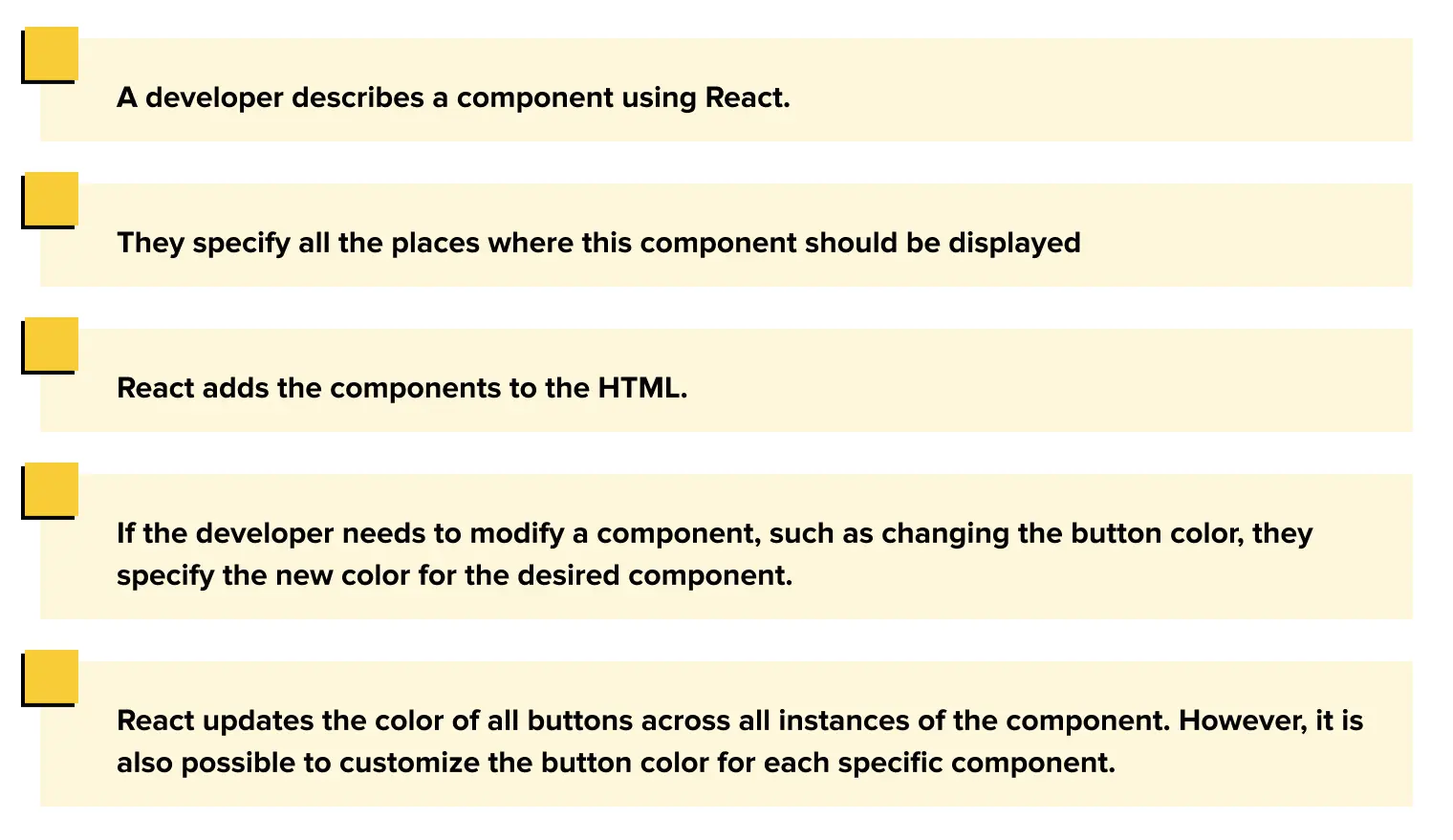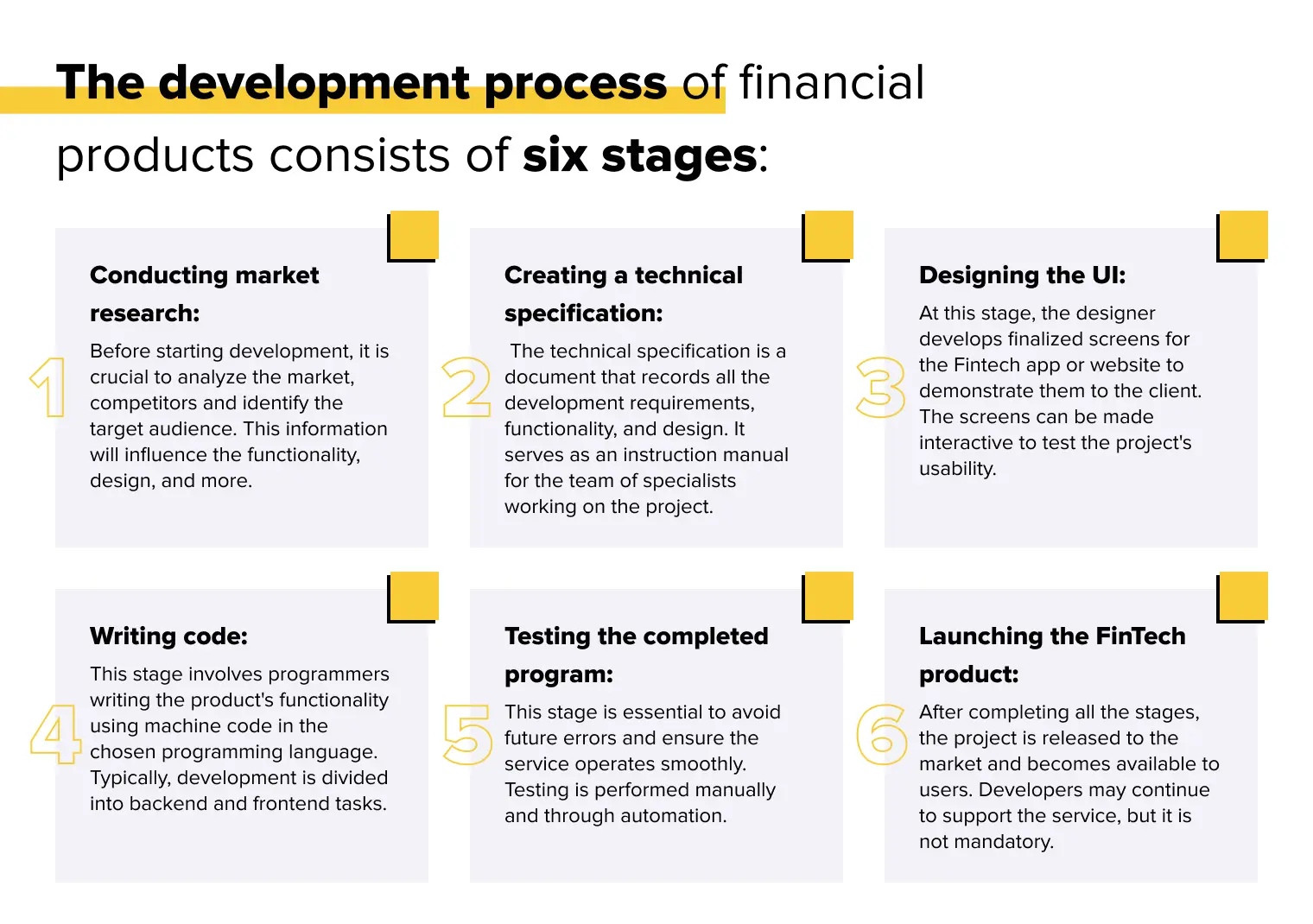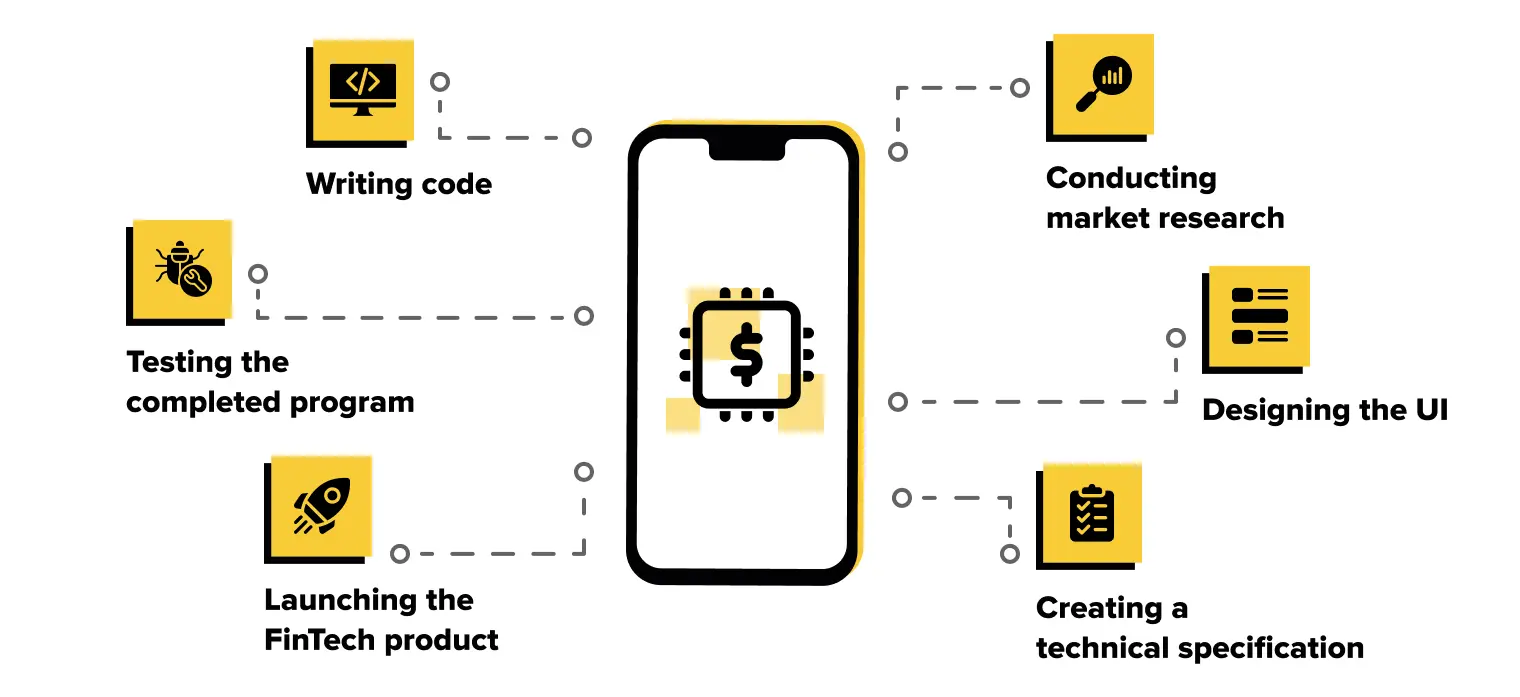FinTech is one of the fastest-growing industries in the world. According to a report by IndustryResearch, the global FinTech market is projected to reach $16,652.68 billion in 2028. To put it into perspective, this figure was $6,588.78 billion in 2021, with a cumulative annual growth rate of 13.9%.
The FinTech industry's growth can be attributed to the widespread presence of various digital solutions, enabling companies to enhance their offerings and provide services to customers worldwide.
According to a survey conducted by EY, 96% of the 27,000 consumers surveyed across 27 global markets reported that they know about FinTech services, with 75% having used them.
Every year, new FinTech apps emerge in the financial market, aiming to automate processes and improve the quality of financial services. These apps help companies transform and compete for leading positions, leaving traditional banking institutions behind.
These solutions benefit companies and customers, as individuals can easily and quickly access financial services using technology, regardless of the time.
In this piece, experts from Lampa Software will discuss the specifics of developing FinTech applications and what are the advantages of React JS, a technology employed in creating digital products. Our React JS services showcase how this framework can be leveraged to build robust and efficient solutions.

What is React JS?
React JS is not a framework (as many mistakenly claim) but rather a third-party open-source library written in JavaScript. And it is in this distinction that the benefits of using React become apparent, such as its ability to integrate with other JavaScript libraries.
For instance, the Angular framework has all its features set in stone and can only be used in one specific way, whereas React JS can be utilized according to the developer's needs.
Created by Facebook, this library was released in May 2013 and is now used not only for web interface development but also for mobile app development (React Native) and desktop apps (React with Electron).
Since its launch, React JS has taken the front-end development space by storm.
According to Statista, as of 2022, React JS ranks second among the most in-demand web platforms worldwide, second only to Node JS.
Its popularity stems from the fact that it can tackle tasks of any complexity. Especially when leveraging additional React components, which integrate into projects and allow for the creation of stylish, practical interfaces, the development of Fintech apps can become multifunctional.
Thanks to this library, the deployment of products and interactive UI interfaces is significantly accelerated. Developers using React JS need to write less code than if they were trying to program the interface using only standard JavaScript.
To provide the functionality to a component in a React JS Fintech app, it is sufficient to describe how specific parts of the interface will look in different states. There is no need to modify existing code. Additionally, the logic is described in JavaScript rather than in templates, enabling the passing of any data throughout the app.
If we were to draw an analogy with the real world, development with React JS can be likened to assembling a Lego construction set. In other words, you create reusable components. These blocks are individual, independent parts of one large interface. When assembled, these blocks form the entire user interface of the Fintech application.
How Does React JS Work?
To understand what are the advantages of React, let's delve into how the library works. We'll explore two programming approaches: imperative and declarative. Let's use a taxi analogy:
If a passenger tells a taxi driver, "Turn the wheel to the right, and now to the left. Press the gas pedal, hit the brakes," that's an imperative approach. The passenger describes each action the driver should take to achieve the result (arriving home).
If a passenger provides an address, and the taxi driver autonomously determines the route and monitors shifts and turns, that's a declarative approach. The passenger describes the desired outcome (the destination to reach) and how to react to external events, like "If we encounter an hour-long traffic jam, drop me off at the nearest subway station."
React JS operates on the principle of a declarative approach. It's called "UI as a function of data" – a developer describes how the interface behaves based on data and events. With React JS, IT specialists don't need to explain each action.
UI descriptions in React JS become components assembled to form the interface. Components represent forms, buttons, fields, and screens in Fintech apps. Developers create them from scratch or utilize third-party libraries. Furthermore, they can nest components within one another, reuse them, or modify them:

The trick lies in the separation of component creation and configuration. First, the developer defines how a component should look and behave, such as a button, and which properties can be customized. Then, they place configurations of buttons in different locations, for example, a medium-sized green button in a form, a large yellow button in the shopping cart, and a small gray button on the main screen.
Specific Features of Development FinTech Apps
Technological progress and development have enabled the integration of IT solutions into the financial sector. This opens up opportunities to develop various products for both customers, such as creating a mobile banking application and more complex systems with narrower usage.
The development process of financial products consists of six stages:

Developing Fintech applications has its specific requirements, including attention to security, reliability, and compliance with regulatory standards.
Let's consider the key nuances to consider:
User account management: Develop a dashboard where individuals can conveniently manage their finances and quickly access information. For example, if it's a banking appl, provide access to essential operations related to cards, accounts, and more. Such Fintech technologies enhance the usability of the service.
Ensuring two-way system security: From the user's perspective, implement mechanisms to protect personal accounts and data. For instance, incorporate authentication methods using additional credentials or biometrics. Safety should also be ensured on the server side to prevent the compromise of the entire system and potential data breaches.
Consider the system's load capacity: Evaluate whether the service can handle intensive user traffic, complex financial operations, and other Fintech services. If the product is intended for a wide range of users, it is essential to make the service highly scalable to avoid stability issues.

Main Advantages of React JS
The benefits of React make it a flexible and powerful tool for web development. Let's explore some of them.
Ample Community Support
React has a vast community of developers who actively contribute to the library's development. They create new extensions, plugins, and tools that significantly facilitate the development of Fintech applications.
With a wide selection of components, programmers can quickly find solutions for various tasks and enhance the performance of their projects.
Community members actively exchange professional information and experiences by publishing articles, guides, and tutorials and conducting online courses and webinars. This allows new developers to quickly enter the world of React JS and acquire the necessary knowledge to create high-quality Fintech applications.
Comes with JSX
React JS includes a free syntax extension called JSX (JavaScript XML). It helps describe HTML-like elements using React code. Using React's syntax, developers can create page components and have flexible control over them.
Although the elements resemble HTML, it is still JavaScript with the ability to quickly and easily modify the actual DOM (Document Object Model) using code. Yet, JSX is rendered as HTML: developers describe the desired component in a markup language while it remains a JavaScript object with extensive functionality. This convenience simplifies programming but may confuse beginners.
Component Reusability
Among the many React JS advantages, the library is based on components: individual web interface elements. Components are encapsulated, meaning they are self-contained, with all the necessary methods and data.
Encapsulated self-contained components can be reused, placed in different parts of the code, in different sections, or on other pages. Data can be passed throughout the Fintech app and used outside the specific page's DOM. This speeds up development and reduces the actions required to create a functional interface. The encapsulation and the absence of complex dependencies also make debugging easier.
Component-based architecture
Component-based architecture is a key aspect of the React JS library. It makes the development of user interfaces more organized, modular, and scalable. This enables the creation of Fintech apps of any complexity by breaking them down into numerous small components that can be reused.
Easy to Learn, Easy to Use
Most programmers who are proficient in JavaScript and familiar with the benefits of React JS can grasp the library in just a few days. Initially, it may seem complex, but once specialists understand the core components and how they work, coding becomes smooth. With simple functions, developers can create highly intricate Fintech apps.
Effortless Maintenance
Creating Fintech applications with multiple integrations can be a challenging task. However, maintaining them to accommodate evolving business requirements can be even more complex and costly. But not with React JS. The library has a modular and flexible architecture that allows changes for each component individually. As a result, modernizing and maintaining applications requires much less time.
Fast Rendering
This is a key React advantage. One of the features of React JS is its creation and caching of a virtual DOM tree—a copy of the DOM that can be modified faster than the actual structure. This is done to update pages quickly. When an interactive user performs an action or an event occurs, the DOM needs to change as objects on the page change. However, the real DOM can be massive, and updating it can be slow. That's why React JS works with a lightweight virtual copy stored in the cache.
This means that React JS doesn't update all elements on the page, only those that have changed, making the Fintech application smaller and faster.
Flexibility
React is a highly flexible and versatile JS library, making it easy to adapt to the specific needs of individual consumers. This advantage of React allows the same code to be used in multiple projects, create new Fintech apps based on it, and even utilize it in an existing codebase without major modifications.
Handy developer tools
React JS offers a plethora of useful developer tools. Some are popular and well-known, while others may be lesser-known but offer convenient functionality.
Front-end developers often utilize the browser's console and developer panel to test their code. Developer tools simplify the task and enhance capabilities. For example, developers can inspect deeply nested components directly in the browser, saving time searching through the code.
Performance
When discussing the React benefits, it's important to mention that the library utilizes the Virtual DOM algorithm, which minimizes the number of changes and, in turn, enhances the performance of Fintech app development.
Additionally, performance optimizations can be achieved by using keys for unique element identification in lists, memoization (to preserve computation results), and deferred state updates (to group multiple updates and execute them simultaneously).
Redux Facility
Redux, an open-source JavaScript library, is considered the most important tool in the React JS ecosystem. Its main purpose is to manage the state of Fintech apps. It provides a set of functions that greatly simplify data transfer through context. Moreover, Redux facilitates debugging and code testing and improves server-side rendering.
Search Engine Friendly
Search engine optimization is key to the success of any online business. Having a website appear on the first page of search results for relevant queries attracts more users.
Many websites struggle to rank on the first pages of search results because search engines find it difficult to read and rank JavaScript-based pages. However, the Virtual DOM feature in React JS provides a more accurate representation of the Fintech app and returns it as a regular web page.
As a result, search engine bots can easily crawl React JS websites, analyze their relevance, and rank them in search results without much effort.
Simplified Scripting
One advantage of React JS lies in its declarative and component-based nature, which simplifies scripting. When developers create a script, they describe how the user interface should appear in different states rather than the steps to achieve it. This makes the code more understandable and easily readable.
With JSX, React JS allows writing HTML-like code directly within JavaScript, making it more intuitive and similar to conventional HTML markup. Developers don't need to explicitly create DOM elements manually. They can use familiar HTML syntax and attributes to describe the interface.
Stable and Streamline Code
React JS employs a unidirectional data flow and virtual DOM to update the user interface, ensuring predictability and stability in Fintech apps. React automatically detects changes in component state and efficiently updates only the necessary parts of the interface. This prevents undesirable failures and errors associated with DOM updates, making the code more stable and reliable.
Stable Code Structure
Thanks to its component-based architecture, unidirectional data flow, JSX, declarative approach, and support for standard practices, React JS provides a stable code structure that facilitates comprehension, maintenance, and extensibility.
Final Words About Advantages of React JS for Fintech App Development
After considering all the advantages of ReactJS, it can confidently be stated that the library is well-suited for FinTech web development. Its virtual DOM model and efficient interface updating mechanism offer great performance. This is particularly crucial in the financial sector, where speed and responsiveness are critical.
Moreover, the modular architecture of React JS allows for the creation of web applications that are divided into independent and reusable components. This reduces the development time for complex financial products and simplifies their maintenance and expansion.
If you want your digital product to encompass all the React JS advantages, turn to Lampa Software. Development using React JS is one of the main areas of our expertise.
Over the years of working with React JS, we have developed and implemented numerous effective solutions that have helped FinTech companies achieve their goals and ensure the successful functioning of their web apps.